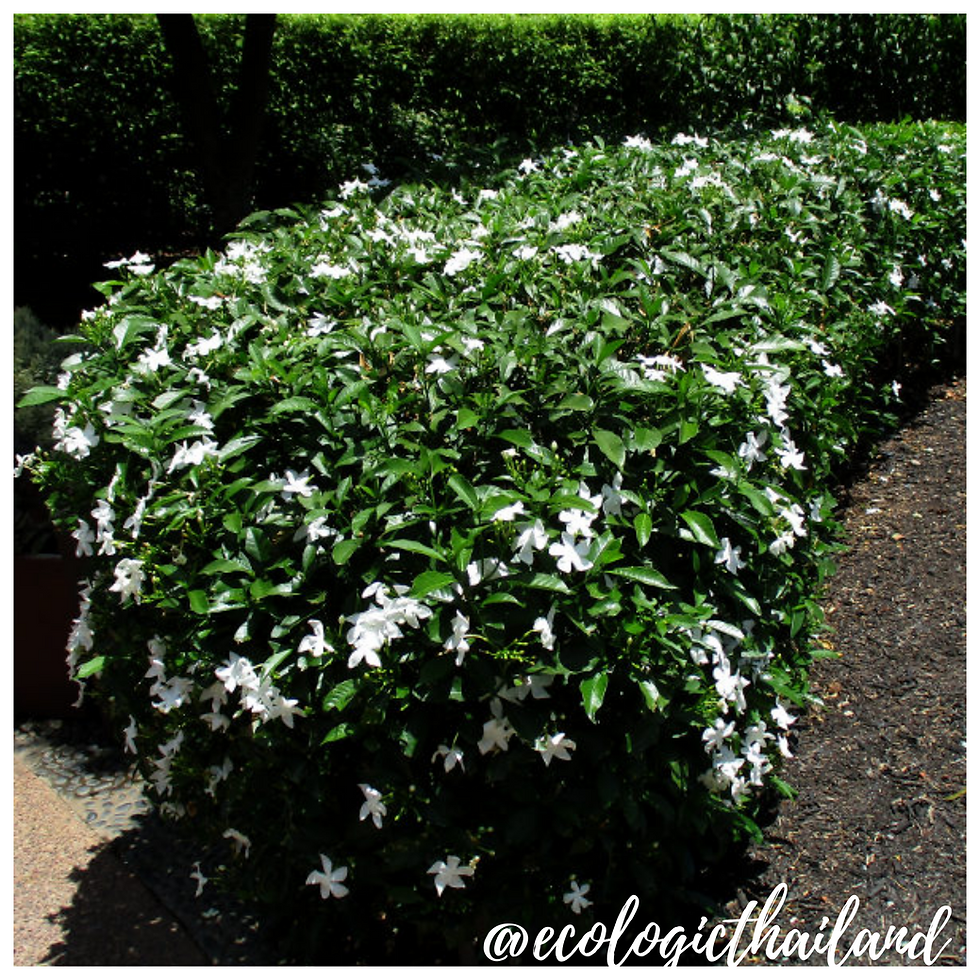Kabocha squash
- Sep 6, 2020
- 3 min read
Updated: Sep 29, 2020
Fúg-Tong | ฟักทอง| Cucurbita maxima
Family: Cucurbitaceae - Genus: Cucurbita

Squashl can be found at the vegetable gardens of the Thai Child Development Foundation around the paths and around the kitchen area of Eco-Logic Thailand on Mount Never-rest.
Kabocha squash can be found in the organic gardens of the Thai Child Development Foundation in Paksong, Thailand. It grows on a vine and the squash is hard on the outside with knobbly-looking skin. It is shaped like a pumpkin and has a dull-finished, deep-green skin with some white stripes and an intense yellow-orange color on the inside. An average kabocha weighs about 1 kilogram. In Paksong we refer to this squash as pumpkin mostly for our dishes at the restaurant. The squash, as well as the flowers and leaves are edible.
Kabocha squash can be harvested about 2 months after planting the seeds, from November to July in Paksong area.

KABOCHA SQUASH PLANT
Kabocha is a vining plant that climbs via tendrils and ut can grow 3 to 5 meter long. In Paksong we use old branches as support for the squash to grow up in the vergetable gardens of the Foundation. It is an annual plant. The above-ground parts are hairy. Spring-like tendrils grow from each node.

KABOCHA SQUASH LEAVES
Leaves simple, alternate, softly hairy, not harsh, long petiolate, leaf-blade broadly cordate to triangular, shallowly lobed.
The plant has five-lobed leaves, alternately arranged on the stem.
The leaves are edible.

KABOCHA SQUASH FLOWERS
There are male and female flowers on a single plant. Flowers have five fused yellow to orange petals and a green bell-shaped calyx.
The flowers are edible.

KABOCHA SQUASH
Kabocha fruits are classified as a pepo (a special type of berry, with a thick outer wall or rind, and a fleshy interior). It grows on a vine and the squash is hard on the outside with knobbly-looking skin. It is shaped like a pumpkin and has a dull-finished, deep-green skin with some white stripes and an intense yellow-orange color on the inside. An average kabocha squash weighs about 1 kilogram.
The flesh is yellow-orang and the seeds are large and fairly flat.
CULINARY USES OF KABOCHA SQUASH
Kabocha has an exceptional sweet flavor. It is said to be similar in texture and flavor to a pumpkin and sweet potato combined.
The rind is edible, as well as the flesh, the seeds, the leaves and the flowers.
Kabocha is used for curries, side dishes and desserts in Thailand. It can be baked, roasted, steamed and stifried.
The leaves from squash and pumpkin plants are not only edible, but they are absolutely delicious and highly nutritious.
NUTRITION
100 gram of Kabocha squash contains:
water 85-91 gram
P\protein 0.8-2.0 gram
Fat 0.1-0.5 gram
Carbohydrates 3.3-11.0 gram
Vitamin A 340-7800 IU
Vitamin B1 0.07-0.14 milligram
Vitamin B2 0.01-0.04 milligram
Niacin 0.5-1.2 milligram
Vitamin C 6-21 milligram
Calcium 14-48 milligram
Iron 70 milligram
Phosporus 21-38 milligram
Magnesium 16-34 milligram
TRADITIONAL MEDICINAL USE OF KABOCHA SQUASH
NOTE: please take advice from a doctor if you are planning to use herbal medicine.
The kabocha squash can be used internally or external in traditional medical use.
Internal:
Pumpkin seeds can expel worms and increase urination. R
The seeds are said to prevent formation of kidney stones.
The orange flesh is nourishing to the tissues, is high in beta-carotene, and is said to help prevent cancer.
It also nourishes eyesight.
The root treats cough and toxins.
External:
Pumpkin flesh soothes inflammation and contusions.
INTO THE WILD: a down to earth experience

For guests and visitors to Paksong we organize weekly tours "The Edible Forest" and Foraging weekends: Into the Wild. We work with local guides to take you in the jungle of Paksong. After foraging, we will cook a meal with the ingredients, using bamboo together with you!
Come and join and learn about the abundance of food that nature gives us!
INTO THE WILD!

















Comments